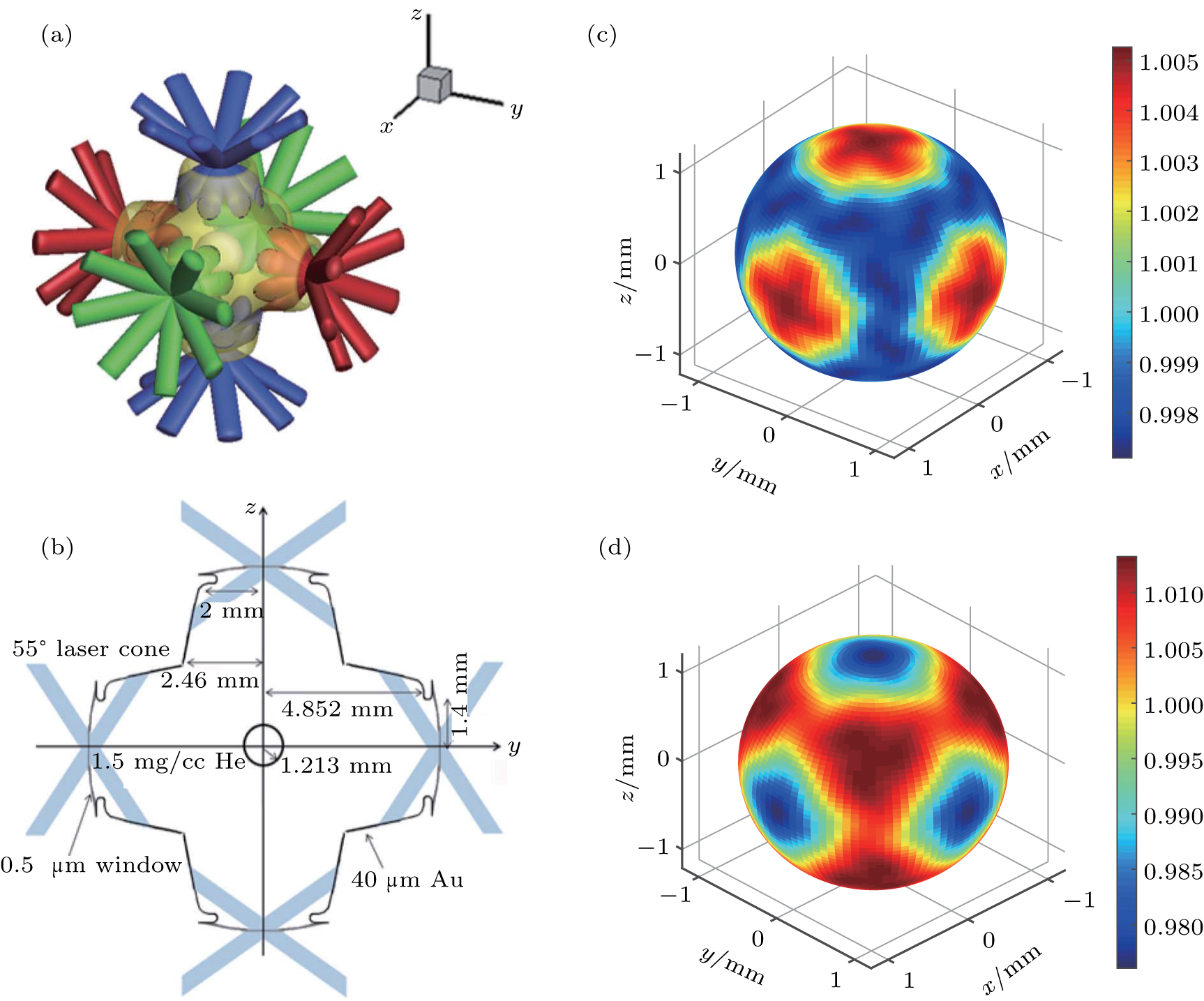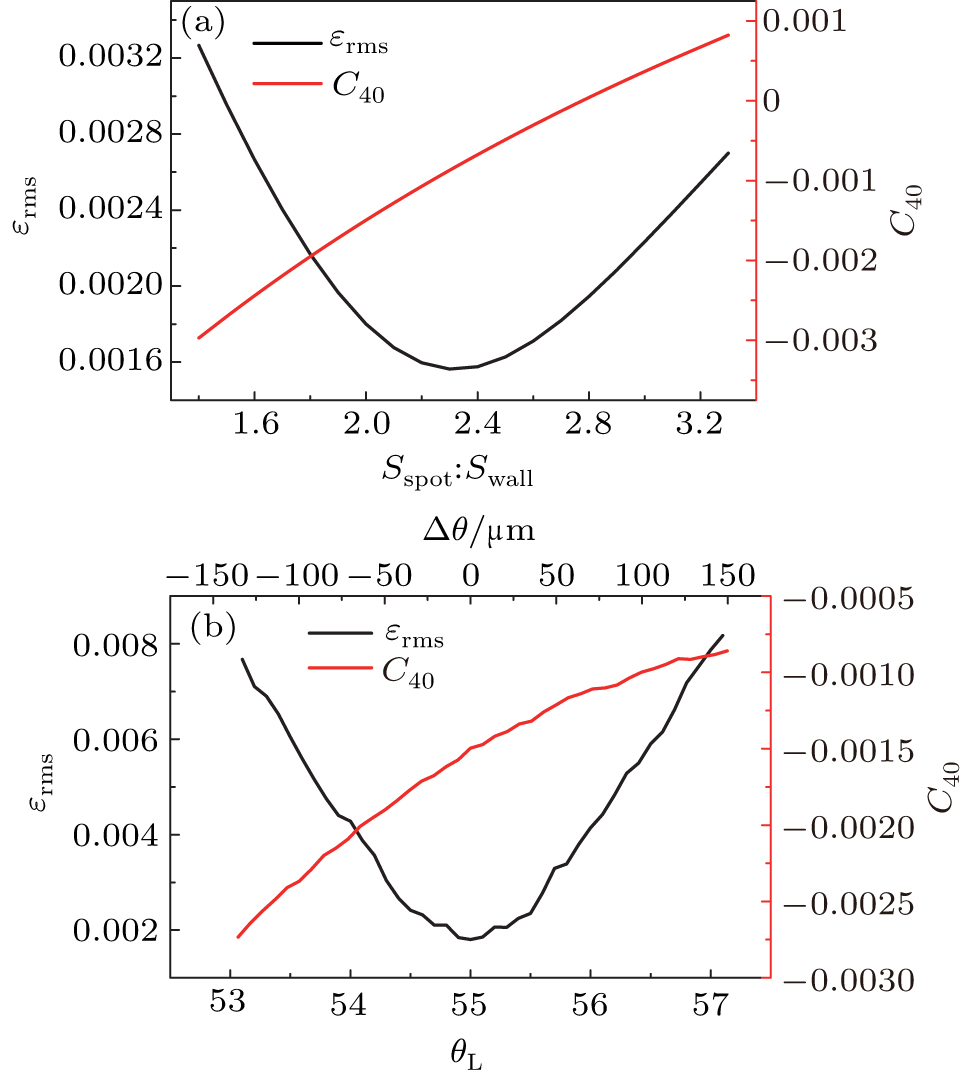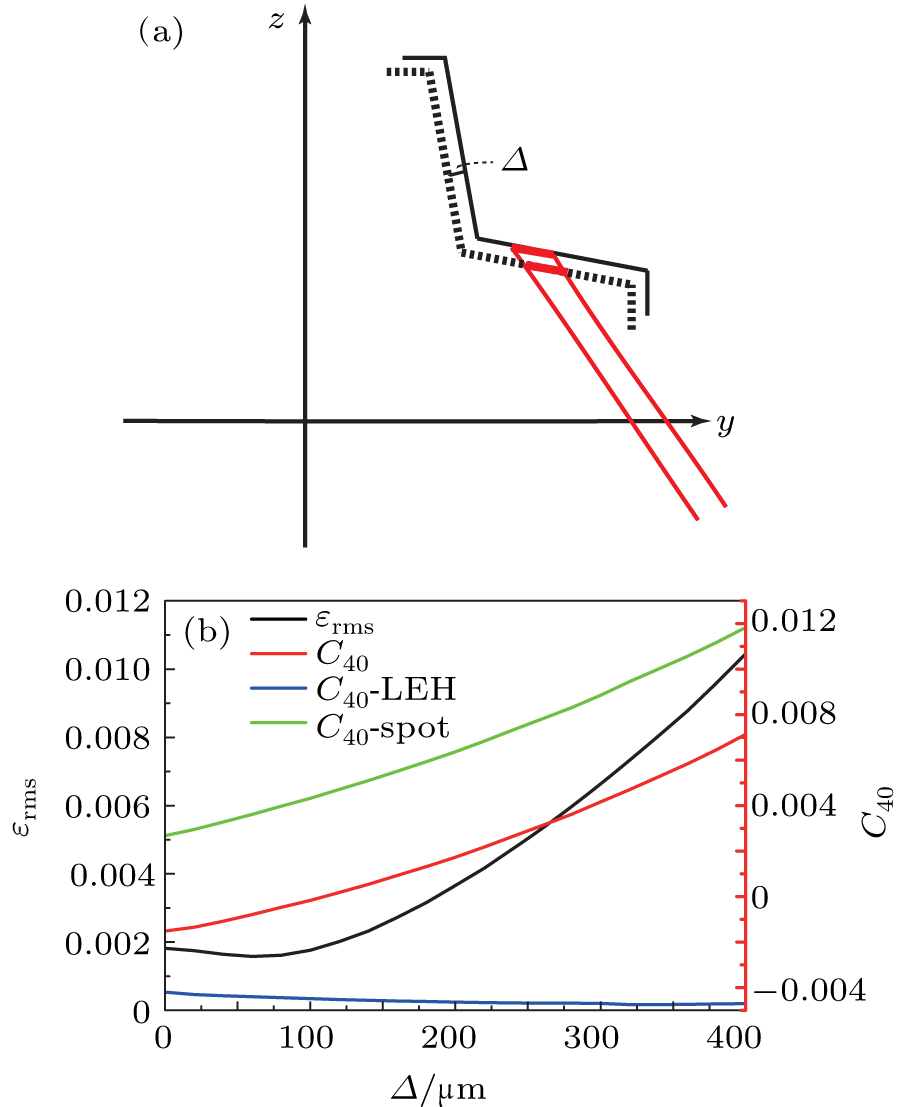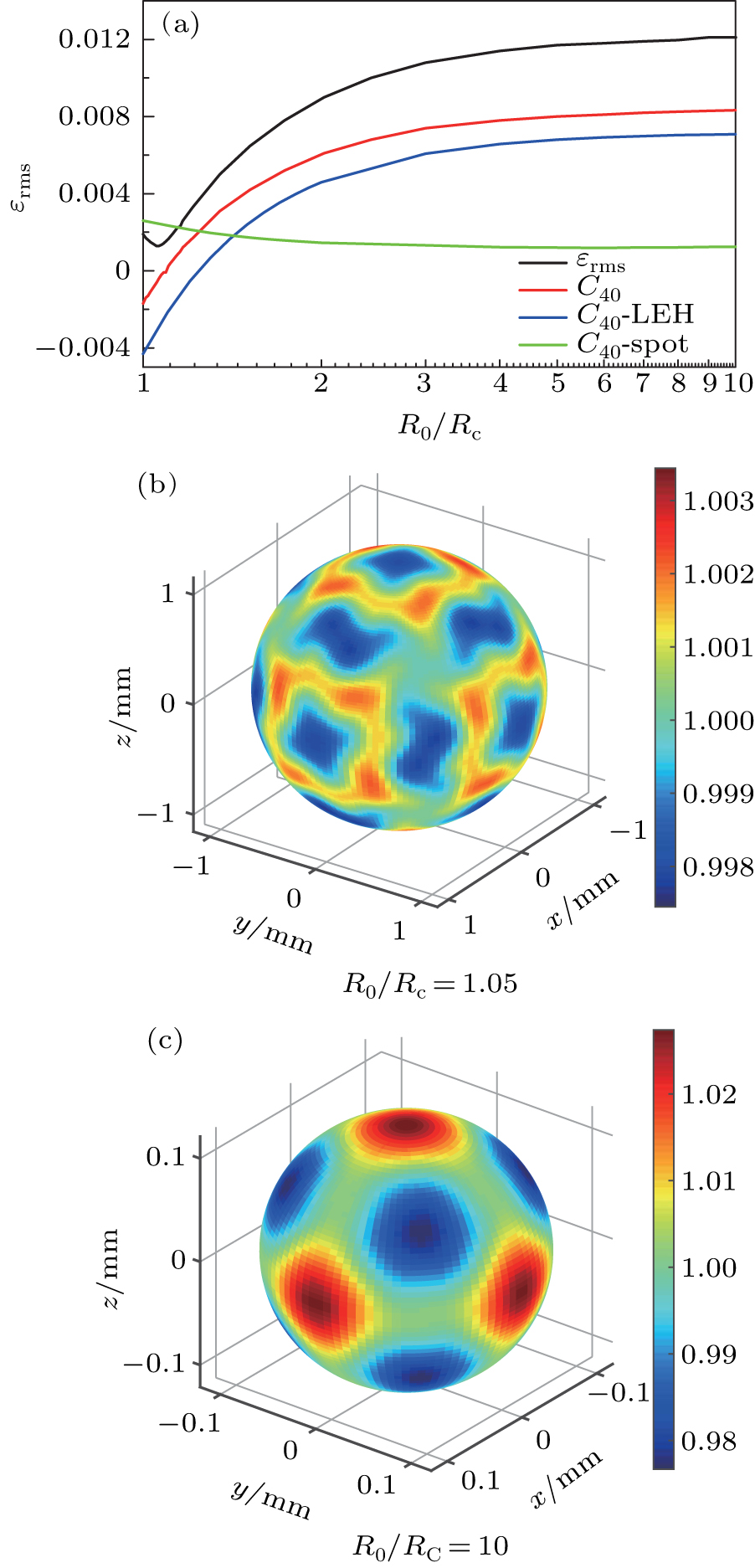Abstract
We have investigated the flux symmetry on the capsule in a six-cylinder-port hohlraum for improving the design of the hohlraum. The influence factors of drive symmetry on the capsule in the hohlraum are studied, including laser power, laser beams arrangement, hohlraum geometric parameters, plasma condition, capsule convergence, etc. The x-ray radiation flux distribution on the capsule is obtained based on the three-dimensional view factor model. In the six-cylinder-port hohlraum, the main drive asymmetry is the C40 mode asymmetry. When the C40 mode asymmetry approaches zero, the drive symmetry on the capsule is optimal. Our results demonstrate that in order to have a high flux symmetry on the capsule in the laser main-pulse stage, more negative initial C40 modes are needed, which can be realized by adjusting the hohlraum geometry parameters. The hohlraum with column length LH = 4.81 mm has an optimal symmetry in the laser main-pulse stage.
Export citation and abstract BibTeX RIS
1. Introduction
Cylindrical hohlraum is most commonly used in indirect-drive central ignition inertial confinement fusion (ICF).[1] The US National Ignition Facility (NIF) used cylindrical hohlraum with two laser entrance holes (LEHs), but the National Ignition Campaign (NIC) failed because of excessive instability of the capsule implosion and some issues with the hohlraum, such as difficulty in optimizing symmetry and laser plasma interaction (LPI) problem.[2] For optimizing symmetry, spherical hohlraum with 6 LEHs has been proposed.[3–5] However, in spherical hohlraum, the laser spots are very close to LEHs, and therefore, the expanding plasma from plasma bubbles could impede laser beams from entering the hohlraum. To avoid this, six-cylinder-port hohlraum has been proposed.[6,7] Although hohlraums with 6 LEHs lose a considerable amount of radiation energy because of the large number of LEHs, the six-cylinder-port hohlraum combines the advantages of cylindrical geometry and laser beams arrangement with 6 LEHs. In the six-cylinder-port hohlraum, every cylinder is relatively independent, and the aforementioned issues in the spherical hohlraum are improved.
The capsule flux symmetry is one of the important aspects of indirect-drive ICF.[8–13] Typical capsule convergence ratios range from 25 to 45, so that the initial drive asymmetry no more than 1% is required. In cylindrical hohlraums, the Legendre polynomial modes P2 and P4 of the flux on the capsule are the main asymmetry modes required to be controlled. The asymmetry is controlled using three or four spot rings. The adjustment of the power ratio between the rings can reduce the P2 asymmetry. The P4 asymmetry is controlled by choosing suitable positions for the laser spots.[14–18] The six-cylinder-port hohlraum with octahedral symmetry[11] has advantages over cylindrical hohlraum with 2 LEHs. Because of the symmetrical geometry with 6 LEHs, there is no Pl (l < 4) asymmetry mode.[11] Higher modes with l > 4 can be neglected because they quickly smoothen themselves with a suitable choice of hohlraum size (these high modes are below the order of 10−4); so, only the P4 asymmetry mode needs to be controlled. In six-cylinder-port hohlraum, through adjusting the incident angle of laser beams, the effects of laser spots and LEHs are compensated, and the P4 asymmetry mode is close to zero.[6]
The sources of asymmetry on the capsule are laser spots and LEHs. Changes in geometrical parameter and evolutions of various physical processes can be attributed to the variations of laser spots and LEHs. The relative intensity, position, and size of laser spots influence their contribution. The laser power and albedo of hohlraum wall affect the relative intensity of laser spots, and the incident angle of laser beams influences their position and size. The shrinking of LEHs and the movement of hohlraum wall[19] caused by plasma expansion affect the symmetry too. In this study, based on the three-dimensional (3D) view factor model,[20] the factors that influence the symmetry on the capsule have been investigated for improving the design of the six-cylinder-port hohlraum. The effect of capsule compression on symmetry has also been studied. The variation in flux symmetry with changes in various geometric parameters has been simulated. Based on these simulation results, the design of the six-cylinder-port hohlraum has been optimized.
This paper is arranged as follows. In Section 2, the characteristic quantities for describing the flux symmetry on the capsule are introduced. In Section 3, based on the 3D view factor model, the simulation results of various factors influencing the flux symmetry on the capsule are discussed. In Section 4, a new design for the six-cylinder-port hohlraum is proposed. In Section 5, the conclusions based on the results obtained in the study are presented.
2. Characteristic quantities
There are, in general, two measurements of the radiation flux symmetry on the capsule; one is peak-to-valley εptv expressed as Eq. (1) and the other is root-mean-square εrms expressed as Eq. (2).[21]


Here, Sc is the radiation flux distribution on the capsule, Rc is the radius of the capsule, and dAi is the area of element i on the capsule. Smax and Smin are the maximum and minimum radiation flux intensities on the capsule, respectively. S0 is the average radiation flux intensity on the capsule, which is given by

The radiation flux on the capsule has a significant influence on the compression of the capsule. Because different modes have different response on the behavior of capsule implosion, it is necessary to know the amplitude of various modes. The radiation flux distribution on the capsule can be represented by a spherical harmonic function

Ylm(Ω) is an l, m degree spherical harmonic. Clm is a spherical harmonic coefficient given by

The correlation between the spherical harmonic coefficients and εrms can be expressed using Eq. (6)

εptv cannot describe the flux asymmetry globally; so, in this study, we are more focused on εrms and Clm, especially C40.
3. Simulation results
In order to realize the sensitivity of various influence factors on capsule drive asymmetry, the single factor effect is studied. In our simulations, unless otherwise stated, the geometric parameters of the hohlraum are shown in Figs. 1(a) and 1(b). The relative intensity of spot changes with the temperature in the hohlraum. The relative fluxes of the laser spot, the hohlraum wall, and the LEH are simply approximated as 2, 1, and 0, respectively. The nominal spot is 400 μm×600 μm at the best focus.
Fig. 1. Schematic diagram of six-cylinder-port hohlraum and two sources of asymmetry. (a) Illustration of the hohlraum with six cylinder ports, 48 laser quads, and centrally located fusion capsule. (b) Hohlraum geometry. (c) and (d) Radiation flux distributions on the capsule only with laser spots and LEHs, respectively.
Download figure:
Standard imageThere are two sources of asymmetry on the capsule: the laser spots yield positive contribution, and the LEHs generate negative contribution. In the six-cylinder-port hohlraum with geometric parameters as shown in Fig. 1,[6] the contribution of laser spots is C40 = 0.19%, εrms = 0.29%, and the contribution of LEHs is C40 = −0.34%, εrms = 0.46%. The total asymmetry on the capsule is the superposition of the two contributions: C40 = −0.15%, εrms = 0.17%. The contribution of LEHs is greater; so, the holistic asymmetry on the capsule is negative.
Laser spot is one of the sources of asymmetry on the capsule, and the relative intensity, position, and size of the spot affect its contribution. In a hohlraum, the albedo of hohlraum wall and the laser power can change the relative intensity of laser spots. In the pre-pulse stage, the albedo of hohlraum wall is small, and the relative intensity of spots is high. With the increase of temperature in the hohlraum, the relative intensity between the spot area and the non-spot area gradually decreases. We find that the radiation symmetry on the capsule is optimal while relative intensity of spots keeps the value of 2.3 for the design described above (as shown in Fig. 2(a)). In the main-pulse stage, the intensity ratio of the spot area and the non-spot area is close to 2.0, and the symmetry on the capsule is also good.
Fig. 2. (a) Flux symmetry as a function of relative intensity of laser spots, denoted by Sspot:Swall. (b) Flux symmetry as a function of laser injection angle θL. Δθ is the distance of deviation from the spot position of θL = 55°. Red line and black line represent C40 and εrms, respectively.
Download figure:
Standard imageIn the hohlraum with fixed geometric parameters, laser beam focus size, and laser beam arrangement, the position and shape of the spot are only influenced by the incident angle of the laser (denoted as θL). In the six-cylinder-port hohlraum, while θL = 55°, the contribution of laser spots to the capsule compensates the negative contribution of LEHs very well; thus, the symmetry on the capsule is the best, but there is still a little C40 (Fig. 2(b)). In Fig. 2(b), Δθ is the distance of deviation from the spot position of θL = 55°. With larger Δθ, the symmetry is worse.
In the design of the hohlraum, the LEH size is a very important parameter. On one hand, a sufficiently large LEH is needed to ensure the normal injection of the laser. On the other hand, a bigger LEH will cause more leakage of laser energy and lower radiation temperature in the hohlraum. With the plasma temperature rising and the plasma expanding, shrinking of LEHs occurs, which may affect not only the laser injection, but also the flux symmetry on the capsule. As shown in Fig. 3(a), with the shrinking of LEHs, they become smaller in the view field of the capsule. Therefore, the negative contribution of LEHs is reduced, and the asymmetry mode C40 changes from negative to positive. The total asymmetry index εrms reaches its minimum when RLEH ≈ 1.0 mm (C40 approaches zero).
Fig. 3. (a) Flux symmetry as a function of radius of LEH RLEH. (b) Flux symmetry as a function of column length LH. Red line and black line represent C40 and εrms, respectively.
Download figure:
Standard imageIn the six-cylinder-port hohlraum, the relative independence of each column is very beneficial to the symmetry control, and tuning column length of the hohlraum is an important method for changing the symmetry on the capsule. As shown in Fig. 3(b), as the length of each column LH increases, the solid angle of LEHs to the capsule decreases, C40 increases gradually, and the εrms first becomes smaller and then becomes larger. When LH ≈ 4.9 mm, εrms is close to the minimum and the symmetry on the capsule is optimal. LH = 4.852 mm is close to the optimal column length.
With the injection of the laser, the internal temperature of the hohlraum gradually increases, the wall material with high Z expands, the laser energy deposit area and radiation shining surface move inward (schematic shown in Fig. 4(a)). Figure 4(b) depicts the symmetry varying with Δ, which is the distance of movement of the hohlraum wall from the initial position. In the view field of the capsule, the inward movement of laser spots makes them reach near the capsule, and the C40 contribution from the spots increases gradually. While the negative contribution from LEHs keeps unchanged, the total C40 changes from negative to positive. When Δ = 70 μm, C40 is close to zero, and the symmetry on the capsule is optimal.
Fig. 4. Movement of laser spots affects the symmetry on capsule. (a) Schematic diagram of spot movement. (b) Flux symmetry as a function of Δ, which is the distance of movement of the hohlraum wall from the initial position. Green, blue, red, and black lines represent C40 contribution from spots, C40 contribution from LEHs, total C40, and εrms, respectively.
Download figure:
Standard imageIn the preceding simulations, we do not consider the shrinking of the capsule. In the process of capsule implosion, the capsule will be highly compressed due to radiation ablation. The changes of the capsule size cause changes in the flux symmetry. We denote R0 as the initial radius of the capsule, and R0/RC represents the convergence ratio. As shown in Fig. 5, in the process of capsule implosion, the convergence ratio becomes larger, and C40 changes from negative to positive. The C40 contribution from LEHs becomes zero when the distance between LEH and the capsule center is 5 times the capsule radius, and then the smooth factor changes its sign (as shown in Fig. 9.15 in Ref. [21]). So, the C40 contribution from LEHs changes from negative to positive. Surprisingly, with the shrinking of the capsule, the contribution from spots changes a little. When R0/RC = 1.1, C40 ≈ 0, εrms is minimum, and the symmetry is optimal. In Figs. 5(b) and 5(c), at the beginning of capsule implosion, the six areas of capsule corresponding to the LEHs are dark (blue areas), and after C40>l0, they become bright (red areas). When R0/RC>10, εrms changes slightly, the bright and dark areas clearly separate, and the flux symmetry becomes worse.
Fig. 5. Variation of symmetry with the compression of capsule. (a) Flux symmetry as a function of the convergence ratio R0/RC. Green, blue, red, and black lines represent C40 contribution from spots, C40 contribution from LEHs, total C40, and εrms, respectively.
Download figure:
Standard image4. Design optimization
In the design of hohlraum, the time evolution of flux asymmetry must be considered. Because the capsule can endure slightly higher asymmetry in the pre-pulse stage, but capsule is very sensitive to the asymmetry in the main-pulse stage, the hohlraum design should be optimized to endure good flux symmetry during main-pulse stage.
From the above results, we find that the asymmetry on the capsule is derived from the joint contribution of the laser spots and LEHs, and C40 mode is the main residual asymmetry. To control the asymmetry on the capsule in the six-cylinder-port hohlraum, we should mainly regulate the C40 mode. The simulation data above provide a basis for regulating the symmetry of main-pulse stage. A simple and effective method is to use the column length LH to control the symmetry, while the other parameters are fixed, such as intensity of laser spots and other hohlraum size. The shrinking of capsule, movement of hohlraum wall, and compressing of capsule are included. It should be noticed that with the time evolution, all of them have the tendency to make C40 from negative to positive.
In a radiation hydrodynamic simulation of a six-cylinder-port hohlraum with geometric parameters as shown in Fig. 1(b), the movement of hohlraum wall (Δ), shrinking of LEHs (Δ_RLEH), and laser power (PL) change as a function of time, as shown in Fig. 6(a). In this simulation, foam wall material and CH liner have been used to restrain the movement of the hohlraum wall and shrinking of LEHs. When t = 19 − 22 ns, the laser is in the main-pulse stage, and the movement of the hohlraum wall and shrinking of LEHs are obvious. In the laser main-pulse stage, Δ>70 μm, and to have high symmetry in this stage, more negative initial C40 is needed. As shown in Fig. 3(b), a smaller LH makes the initial C40 more negative. The flux symmetry on the capsule with different LH values changes as a function of time, as shown in Fig. 6(b). In the hohlraum with LH = 4.852 mm, εrms is optimal at t = 10 ns, and εrms becomes larger in the laser main-pulse stage. Smaller initial LH makes εrms be optimal subsequently. In the t = 19–22 ns stage, the hohlraum with LH = 4.81 mm has the best symmetry. The 3D view factor model is a highly approximate model, thus our quantitative optimization is uncertain when considering all complex physical processes in the hohlraum. In general, the six-cylinder-port hohlraum is a well-adjustable design.
Fig. 6. (a) Movement of hohlraum wall Δ, shrinking of LEHs Δ_RLEH, and laser power PL change as a function of time. (b) Evolution of symmetry in hohlraum with different LH values.
Download figure:
Standard image5. Conclusion
In indirect-drive ICF, the x-ray radiation symmetry on the capsule is an important issue for compression and ignition. The six-cylinder-port hohlraum is a new design with advantages of cylindrical geometry and laser beams arrangement with 6 LEHs, and it is predicted to have good symmetry. In this study, the factors that affect the drive symmetry of the capsule in the six-cylinder-port hohlraum, such as intensity of laser spots and laser incident angle, geometric parameters of the hohlraum, movement of hohlraum wall, and capsule compression, have been investigated.
When the C40 mode asymmetry approaches zero, the drive symmetry on the capsule is optimal. The changes of physical state in the hohlraum, such as movement of hohlraum wall and shrinking of LEHs, always change C40 from negative to positive. Changing the initial C40 can adjust the time at which the capsule attains the optimal symmetry. The column length LH has been used to control the initial C40. A suitable value of LH can render the capsule better symmetry in the main-pulse stage.
In this study, the radiation on the capsule has been simulated using the 3D view factor model, which is a highly approximate model. In a future study, the symmetry obtained using the radiation hydrodynamics code will be discussed.
Footnotes
- *
Project supported by the National Natural Science Foundation of China (Grant No. 11705010) and China Postdoctoral Science Foundation (Grant No. 2017M610821).





